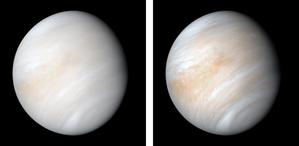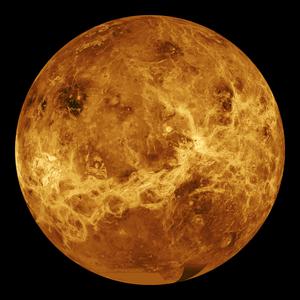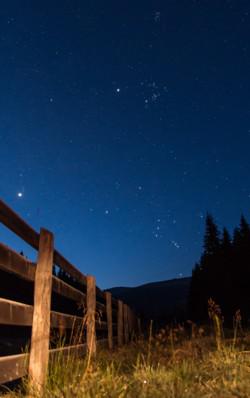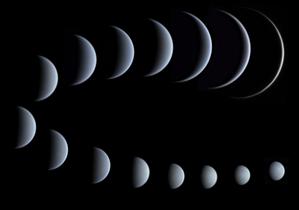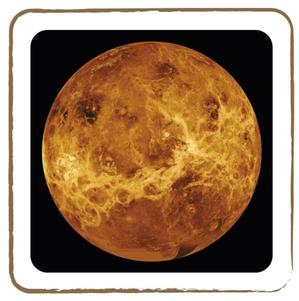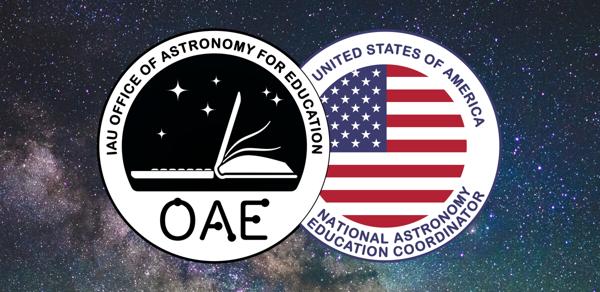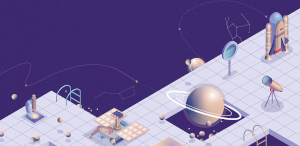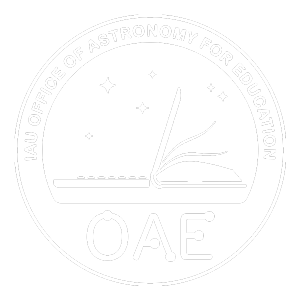Glossary term: Vénus
Description: Vénus est la deuxième planète la plus proche du Soleil. Souvent appelée la jumelle de la Terre, c'est une planète rocheuse et terrestre dont le rayon est légèrement supérieur à 6 000 kilomètres (km), soit environ 95 % du rayon de la Terre. Sa masse est 0,815 fois celle de la Terre. L'atmosphère de Vénus est 90 fois plus dense que celle de la Terre. Elle est principalement composée de dioxyde de carbone et d'épais nuages d'acide sulfurique qui recouvrent toute la surface. L'atmosphère épaisse produit un effet de serre très important, qui se traduit par une température de surface de 460 degrés Celsius.
Sa distance typique par rapport au Soleil est de 108 millions de kilomètres, soit environ 0,72 unité astronomique (distances Terre-Soleil). Il lui faut 224,7 jours pour parcourir une orbite. Vénus met beaucoup de temps à tourner une fois sur son axe par rapport aux étoiles lointaines ; un jour de Vénus correspond à 243 jours terrestres. C'est plus long que le temps nécessaire à Vénus pour effectuer une orbite autour du Soleil. Vénus n'a pas de lunes connues.
Vénus doit son nom à la déesse romaine de l'amour. Vénus étant très proche du Soleil, elle est souvent visible dans le ciel nocturne peu avant le lever ou après le coucher du Soleil. À ces occasions, Vénus est remarquablement brillante, même à l'œil nu, et est traditionnellement appelée étoile du matin ou étoile du soir, respectivement. Avec des jumelles, Vénus présente des phases similaires à celles de la Lune.
Related Terms:
See this term in other languages
Term and definition status: The original definition of this term in English have been approved by a research astronomer and a teacher The translation of this term and its definition is still awaiting approval
The OAE Multilingual Glossary is a project of the IAU Office of Astronomy for Education (OAE) in collaboration with the IAU Office of Astronomy Outreach (OAO). The terms and definitions were chosen, written and reviewed by a collective effort from the OAE, the OAE Centers and Nodes, the OAE National Astronomy Education Coordinators (NAECs) and other volunteers. You can find a full list of credits here. All glossary terms and their definitions are released under a Creative Commons CC BY-4.0 license and should be credited to "IAU OAE".
If you notice a factual or translation error in this glossary term or definition then please get in touch.
Related Media
Vénus en lumière visible
Credit: NASA/JPL-Caltech credit link
License: PD Public Domain icons
La surface de Vénus
Credit: NASA/JPL credit link
License: PD Public Domain icons
To guard the Stars and the Sea Together
Credit: Likai Lin/IAU OAE
License: CC-BY-4.0 Creative Commons Attribution 4.0 International (CC BY 4.0) icons
Romanian Orion
Credit: Alex Conu/IAU OAE
License: CC-BY-4.0 Creative Commons Attribution 4.0 International (CC BY 4.0) icons
Une question de perspective
Credit: Christofer Baez/UAI OAE (CC BY 4.0)
License: CC-BY-4.0 Creative Commons Attribution 4.0 International (CC BY 4.0) icons
Related Activities
Children's Planetary Maps: Venus
astroEDU educational activity (links to astroEDU website) Description: Learn more about our nearest neighbour
License: CC-BY-4.0 Creative Commons Attribution 4.0 International (CC BY 4.0) icons
Tags:
Planetary cartography
, Spatial thinking
Age Ranges:
6-8
, 8-10
, 10-12
, 12-14
Education Level:
Middle School
, Primary
, Secondary
Areas of Learning:
Social Research
Costs:
Low Cost
Duration:
2 hours
Group Size:
Group
Skills:
Analysing and interpreting data
, Asking questions
, Communicating information
, Constructing explanations
, Developing and using models
, Engaging in argument from evidence
, Planning and carrying out investigations
